I currently own a full 1080P widescreen display for my PC being a 24" BenQ FP241W.
The monitor's true resolution is 1920 X 1200.
When playing mojority of Blu Ray or HD DVD movies on my PC, I get massive black bars on my monitor on top and bottom.
My monitor is set to max resolution being 1920 x 1200.
I would have assumed playing 1080P would be 1920 X 1080 meaning I should only get small bars . However, this is not the case.
I am connected via DVI (both monitor and GPU support HDCP).
Is there an explanation for this that i'm missing.
+ Reply to Thread
Results 1 to 18 of 18
-
-
Probably. The movies with the large amount of black bars are most likely 2.35:1 movies, wider than 16:9 (1.78:1) and have the black bars encoded as part of the video. You get a small amount of black bars from the monitor and much more because of the width of the movie.Is there an explanation for this that i'm missing.
Things look "normal" don't they? People aren't short and fat and balls are round? -
I could probably count on one hand the number of DVDs or HD DVDs (sorry, don't have BluRay) I have that were actually shot at 16:9, which will completely fill the screen. So what you are seeing is normal for the reasons manono mentioned. Your playback software might possibly have some kind of zoom feature that will fill the screen, but you'll lose picture information on the sides to do this. I don't recommend it, but I know some people who have some weird pathological hatred of black bars on the screen and this is the only thing that makes them happy.
-
That seems like the resolution being displayed on my monitor.Originally Posted by jagabo
So its to do with the aspect ratio.
I dont like the zoom feature and stretching of the picture, so thats out of the question.
How can movie studios then claim a movie to be full 1080P when 1920 X 1080 pixels in reality is not being shown. -
Where are they claiming "full1080p"? Most BluRay discs clearly state aspect ratio and yes, bit rate is distrubuted to the active picture area. Black bars consume little bit rate.
I thought you were going to bring up the 16:10 (1920x1200) issue. If you connect a 1920x1080p or 1280x720p video device to such a monitor, they usually vertically scale to 16:10 making people look tall. If the source is 2.35:1 it will still have black bars.Recommends: Kiva.org - Loans that change lives.
http://www.kiva.org/about -
My monitor supports 1:1 pixel mapping, so there are no scaling of the picture. The source is displayed exactly as it should be.Originally Posted by edDV
-
Have you never watched a movie on DVD ?
DVDs have been like this long before BluRay came along. The total image area encoded is 1080p (1920 x 1080), it is just that the actual movie doesn't require all this space.
Just like DVDs that are all 720 x 480 (or 576 depending on the format), yet have black bars for any movie wider than 1.78 : 1. The same goes for BluRay, HD DVD and whatever comes next.
My hope is that complaints like this don't eventually drive hollywood to start shooting everything in 16:9 simply to get some peace. Most of the greatest films ever made are wider than 1.78:1, although many are also 1.33:1, which means black bars up the sides instead.Read my blog here.
-
So 1280x720p or 720x576p sources don't scale?Originally Posted by waheed
My Samsung 226bw monitor auto scales to fill the 16:10 screen when directly fed by an HDV camcorder, HD tuner or progressive DVD player (HDMI->DVI-D). 4:3 source has side bars.Recommends: Kiva.org - Loans that change lives.
http://www.kiva.org/about -
My monitor actually has settings that allow for scaling or keep 1:1 aspect ratio which is decent.Originally Posted by edDV
I guess due to the original aspect ratio, I can cope with having black bars. But I was just hoping there were more available titles in 16:9 aspect ratio. -
Blame the TV manufacturers for coming up with an aspect ratio that didn't exist in movies. Or is it the FCC's fault?
-
It was Japanese HiVision research for the ideal home TV aspect ratio (5:3) later replaced by findings of a SMPTE electronic film projection committee led by Kerns H. Powers of the David Sarnoff Research Center. 1.77 to 1 (16:9) was determined to be the ideal electronic aspect ratio that could contain all known movie aspect ratios by letterboxing or side masking. Electronic projection or flat screen display requires a fixed "super" aspect ratio that can contain all the others. The arguement for 16:9 was accepted first in 1985-89 by the CCIR for the CCIR-601* wide digital TV spec (later adopted for the MPeg2 DVD standard) and later by the ATSC and EBU as a basis for HDTV. A 16:9 wide SD or HDTV can display all popular flm aspect ratios without the need to paste on extra pixels left and right. 16:9 also works well for binary addressing.Originally Posted by jagabo
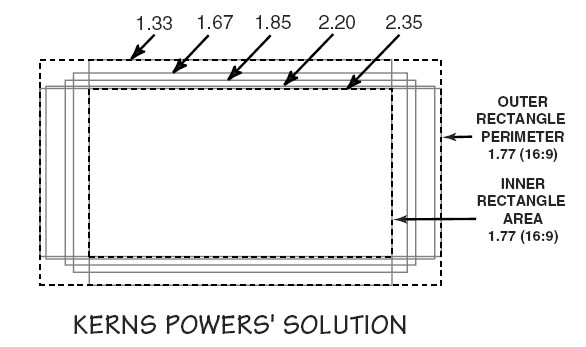
http://www.cinemasource.com/articles/aspect_ratios.pdf
Beyond the technical practicality, consider that a 2.40 to 1 display would leave almost 50% of the screen masked to display 4:3. The screen size would need to be huge to get enough vertical height.
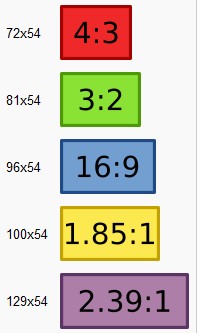
http://en.wikipedia.org/wiki/Aspect_ratio_(image)
* now ITU-Rec. 601-4 (also see SMPTE 125M/259M/292M)Recommends: Kiva.org - Loans that change lives.
http://www.kiva.org/about -
So we end up with a compromise that sucks for everything -- except new made for TV content. Which could just as well be shot at 2.35:1.
Most of the 4:3 stuff is low res and doesn't need to be big.Originally Posted by edDV -
Well it is what it is. Someday there may be 2.35 to 1 displays. No reason why not.
As it is people are surprised how much smaller a 4:3 image is at the same diagonal screen size.
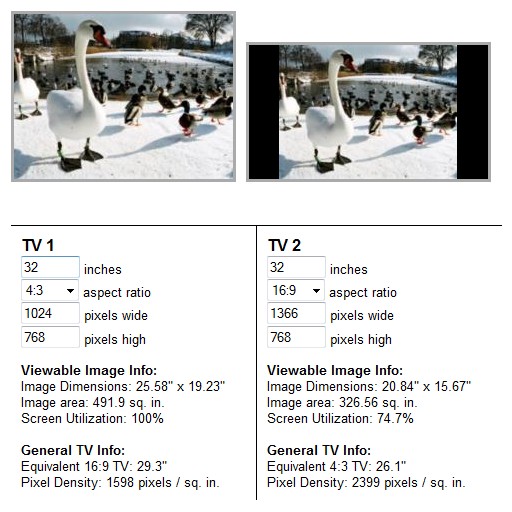
That you need a 40" 16:9 TV to match 4:3 size of a 32"
A 2.35 to 1 TV 19.23" high would need to be 45.19" wide (~50" diagonal).
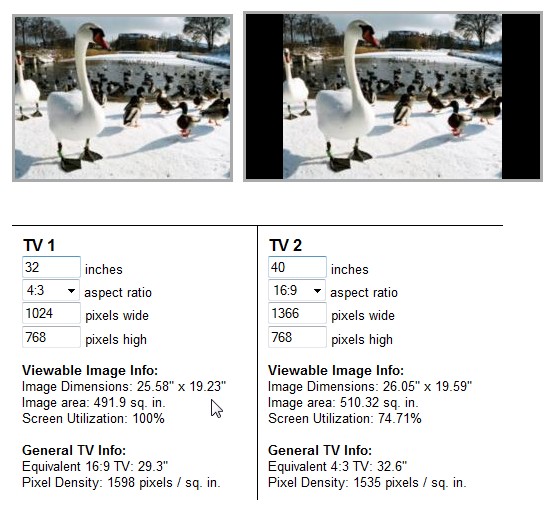
http://www.tvcalculator.com/Recommends: Kiva.org - Loans that change lives.
http://www.kiva.org/about -
At the other extreme, a 2.35 to 1 aspect movie displays this way on the same two TV sets.
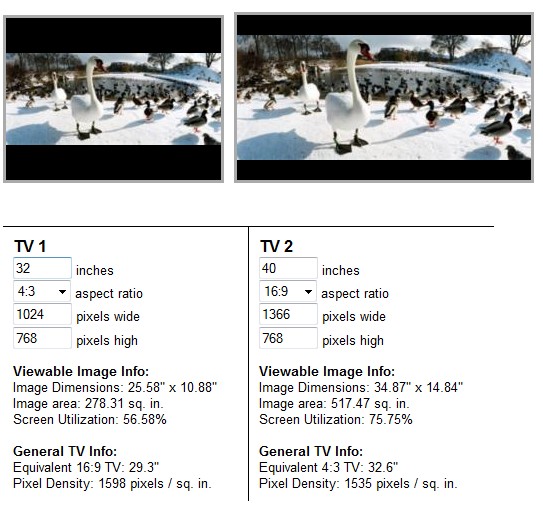 Recommends: Kiva.org - Loans that change lives.
Recommends: Kiva.org - Loans that change lives.
http://www.kiva.org/about -
Here is another thing to keep in mind, next time someone boasts about their display showing FULL HD 1080p. You can tell them, depending on aspect ratio, you are not getting the full 1080 resolution. A 2.35:1 movie will never use the full screen of your HDTV. Thus, it is not truely showing 1080 resolution. But this is being nit picky.

Perhaps the only way to really see the full 1080 encoded resolution, is to use a 1080p projector. Or if only HDTV's came with higher resolution screens than 1920x1080. But I don't think we will ever see higher resolution screens in the near future. -
Resolution of the full frame is 1920x1080p. 1.77 to 1 (16:9) uses it all. 2.35 to 1 uses ~1920x818 with black letterbox fill but that is all that is sent by the transmitter, sat, cable or BluRay disc. There is good news and bad news about this.Originally Posted by Wile_E
Good news is that bit rate is far more important to picture quality than vertical or horizontal resolution. All the transmitted bit rate goes to the active 1920x818 picture area thus increasing picture quality. BluRay extends quality two ways for movies. First MPeg2 bitrate is higher than ATSC (25Mb/s max vs. 19Mb/s max). Second, BluRay movies are encoded at 23.976 fps so 20% fewer frames are stored vs telecined broadcast 1080i.
"Bad" news for the 1080p fans is most broadcast movies have been archived on HDCAM tape as telecined 1440x1080i at 144 Mb/s. Inverse telecine (IVTC) reveals the 1440x1080p/23.976 film source. This needs to be scaled to 1920x1080p before conversion to 1920x1080i or 1280x720p. So for most movies, the only advantage 1080p has over 720p is 12% greater real horizontal resolution and 50% more vertical resolution. BluRay DVD can be mastered to full 1920x1080p from a fresh film transfer but 2.35 to one aspect ratios will only use 818 vertical lines. Projectors offer no advantage.
Live broadcasting can use the full 1920x1080i frame but time shifting for the west coast may limit that to 1440x1080i (HDCAM) or 1280x1080i (DVCProHD). Video servers can be run at any of these resolutions.Recommends: Kiva.org - Loans that change lives.
http://www.kiva.org/about -
More thoughts and context for Kerns Power's Solution (aka father of 16:9).
Way back then (1984), digital video was uncompressed (evolving toward 8 bit 4:2:2 component) and economic real time display scalers were a decade away so this SMPTE projector committee was struggling with ways to project uncompressed digital video in any film aspect ratio without scaling, only masking.
Wide 16:9 uncompressed 4:2:2 (~1988) needed only horizontal scaling for 704x480/576 to 854x480 or 1024x576 wide display.
You can see why 16:9 was a big deal in the uncompressed digital world. One recording format (D1) could handle mastering all popular film aspect ratios.
By the late 90's, DVD had similar issues. Cheap players needed one resolution 720x480/576 without added player horizontal scaling costs. Horizontal wide anamorphic scaling was assigned to non-realtime computative MPeg2 encoding. Playback vertical scaling was easy to do in the player for simple 4:3 letterbox output. Quality full height, horizontal 16:9 scaling was left to future wide TV sets. Analog wide TV sets could H scale by adjusting horizontal scan frequency. Digital wide sets needed a 1.18x to 1.21x horizontal upscale from 704 or 720 to ~854 (1024x576 for PAL).
I'm just adding historical context to this 16:9 issue. Today realtime digital H and V scalers are economic in both the DVD player and HDTV.Recommends: Kiva.org - Loans that change lives.
http://www.kiva.org/about
Similar Threads
-
Why are there black bars at the sides?
By pooksahib in forum Newbie / General discussionsReplies: 12Last Post: 18th Apr 2012, 09:11 -
Adding black bars
By ebay in forum Video ConversionReplies: 4Last Post: 7th Aug 2010, 05:37 -
Black Bars
By cinnamonhearts2 in forum Newbie / General discussionsReplies: 15Last Post: 30th Jul 2009, 13:44 -
black bars or not?
By Cowabunga in forum Video ConversionReplies: 6Last Post: 16th Apr 2009, 13:56 -
Need to cut off black bars
By Dozza in forum EditingReplies: 8Last Post: 2nd Sep 2007, 08:17




 Quote
Quote